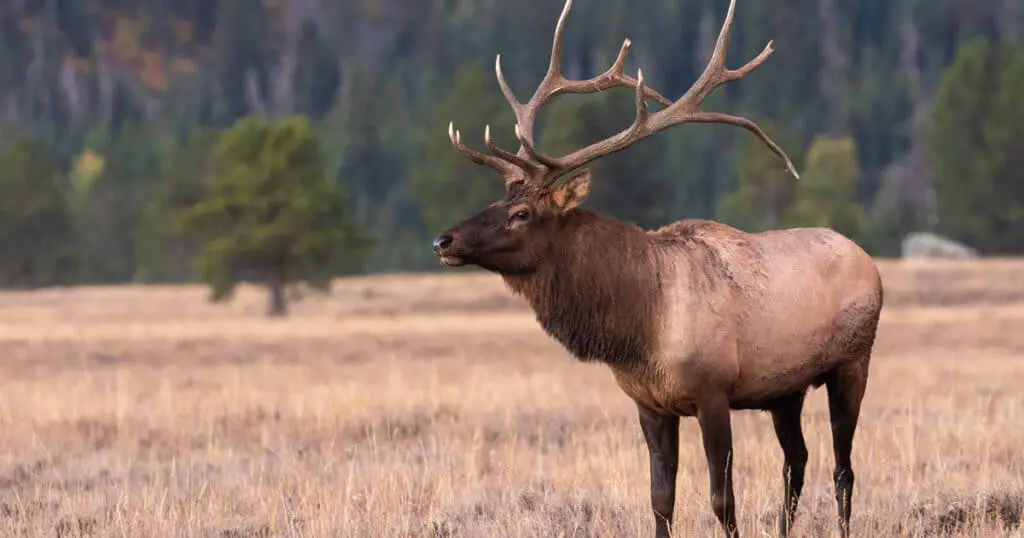Like the white-tailed deer, the North American Elk (also known as the Wapiti) is a cervid. In fact, it’s the second-largest species in the deer family, making it an impressive animal. The North American elk may weigh as much as 1100 pounds. Keep reading to learn everything you want to know about the North American Elk.
In today’s article we’ll learn a bit about the history of this deer species, explore the size of Elk, its appearance, relevant Elk sub-species, its preferred habitats, unique features, and much more.
Brief History of the Elk
Table of Contents
ToggleNorth America was home to as many as 10 million Wapiti before Europeans arrived. These large deer played a significant role in Native American lives and Native culture for thousands of years.
As it’s a remarkably adaptable creature, the elk successfully lived in a wide range of ecosystems.
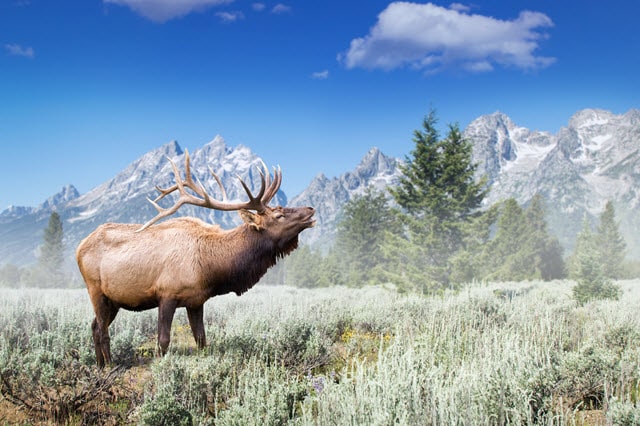
The formal name for Elk, Wapiti, comes from a Cree and Shawnee word. Native Americans hunted these animals for their meat and hides, which they used for making clothing and blankets.
These animals came under serious threat after Europeans arrived and settled across the West. Explorers and settlers destroyed important habitat for these deer, and their hunting methods quickly proved to be unsustainable for the population.
The situation got so bad that the species disappeared from all parts of the United States to the east of the Mississippi River.
By the time the turn of the 20th century arrived, population numbers in the United States has fallen to lower than 50,000.
President Teddy Roosevelt played a major role in bringing attention to the plight of this species. His leadership and activism resulted in new hunting laws and regulations, which helped to preserve this species.
Elk Size
As you may already know, Elk are enormous animals. The only larger cervid is the moose.
Let’s learn about average weight and measurements for these animals in the summary below so you can understand how elk compare to other deer:
Size of Male Elk (Bulls)
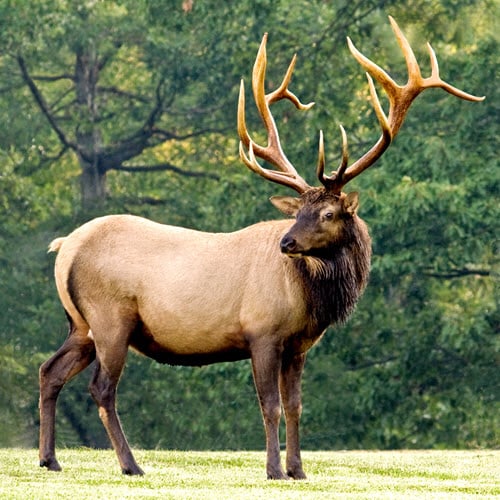
Male elk are called bulls and the typical size of a bull follows:
- Avg. Body Length – 8 feet (2.4 meters)
- Avg. Shoulder Height – 5 feet (1.5 meters)
- Avg. Weight – 700 pounds (315 kgs)
Size of Female Elk (Cows)
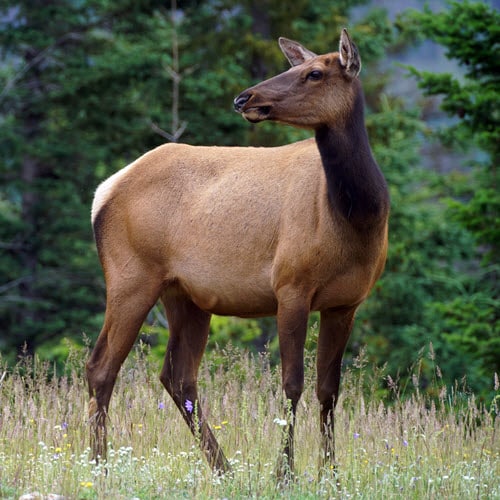
Female elk are called cows, and the typical size of a cow follows:
- Avg. Body Length – 6.5 feet (2 meters)
- Avg. Shoulder Height – 4.5 feet (1.3 meters)
- Avg. Weight – 500 pounds (225 kgs)
It should be noted that the average measurements vary by subspecies.
For example, the average weight for bulls and cows in the Roosevelt subspecies is 900 and 600 pounds respectively.
For the much smaller Tule subspecies, the average bull weight is about 400 pounds, while cows tend to weigh approximately 300 pounds.
Elk Appearance
Let’s explore the appearance of North American elk (Cervus elaphus).
Coat and Color
Elk have a reddish-brown or copper brown coat in the summer months. The coat is tan during the winter and spring, as well as the fall.
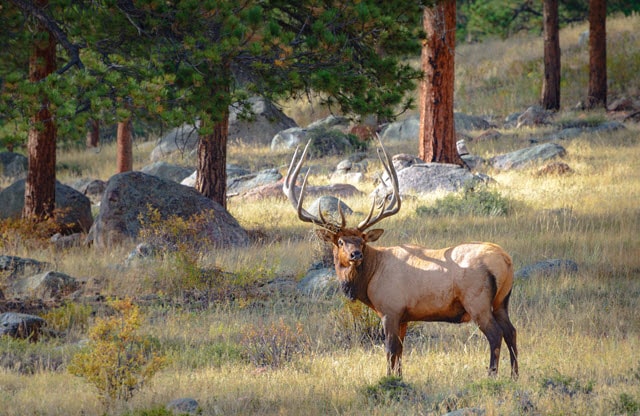
There is also a patch of light beige on the animal’s rump. The belly, legs, neck, and head tend to be dark brown.
The area covering the neck down to the chest develops a dark mane for the winter months. The rump area of the elk’s body is a lighter color, and the tail is a light shade of tan. Sometimes it’s a straw shade.
Size and Weight
As we outlined earlier, there are size differences between male (bull) and female (cow) North American elk.
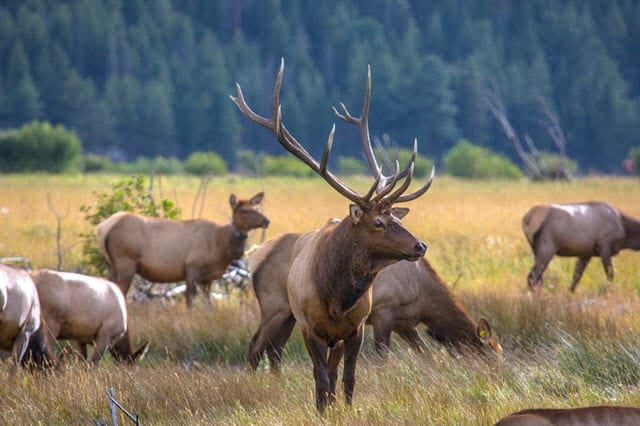
The average bull weight is 700 pounds. A male’s height at the shoulder is as high as 5 feet.
Its length stretching from its nose to its tail is generally around 8 feet. This animal’s antlers are large and make for an even more impressive appearance.
By contrast, females have an average weight of 500 pounds.
Their height at the shoulder is usually around 4 ½ feet. The average length from its nose to its tail is 6 ½ feet.
Antlers
Only bulls grow antlers, and their antlers are enormous. In some cases, they reach a length of 4 feet.
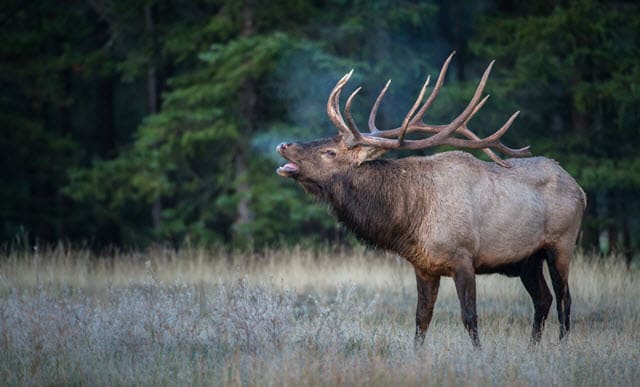
Elk antlers may weigh more than 40 pounds. The animal will lose and regrow its antlers every year.
They grow extremely quickly whenever they regenerate. In fact, daily growth may be as much as one inch.
Each antler may develop seven or even eight points.
Tail
Wapiti have short tails. This is true for both bulls and cows.
Frequently Asked Questions About Elk
How do elk differ from other deer species?
When it comes to differentiating elk from other deer species, key distinctions lie in their size, antler shape, and behavior. Elk are larger than most deer and have a different antler configuration. Their social structure also varies, particularly during the rut, which is more pronounced in elk due to the aggressive behavior and loud bugling of males.
What challenges do elk face in the wild?
Elk face a number of challenges, including habitat loss due to human development, competition for resources, and predation. Climate change also impacts their food sources and migration patterns, adding another layer to their survival puzzle.
How can we help in the conservation of elk?
Supporting wildlife conservation organizations, advocating for the protection of natural habitats, and practicing sustainable hunting are key ways to contribute to the conservation of elk. By educating others about the importance of these magnificent creatures and their role in the ecosystem, we can help ensure their continued existence.
Cervus Elaphus Subspecies of Note
There are six different North American elk subspecies, but two of these are extinct. They are:
- Manitoban,
- Rocky Mountain,
- Tule,
- Roosevelt,
- Merriam’s, and
- Eastern
The extinct subspecies are the Merriam’s (which used to live in Mexico and the Southwestern United States) and Eastern (which lived in the eastern part of Mississippi).
North American subspecies we still have today include:
Manitoban
Manitoban elk (Cervus canadensis manitobensis) live on the northern Great Plains.
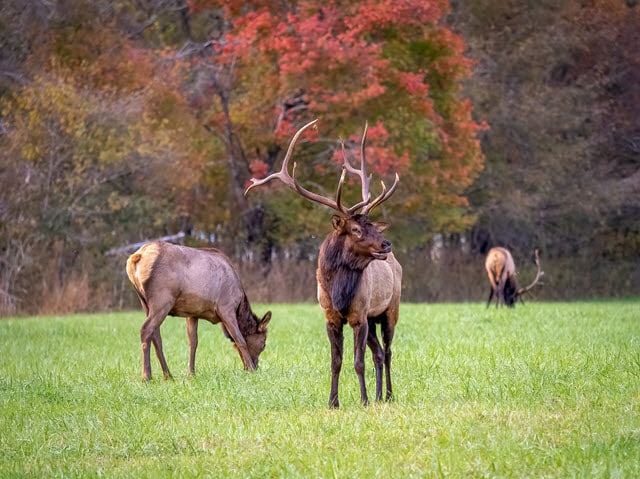
They live in southern parts of the Canadian provinces of Manitoba, Alberta, and Saskatchewan, as well as North Dakota and other parts of the Midwest in the United States.
Rocky Mountain
Rocky Mountain elk were originally found only in the Rocky Mountain West, but since then they have been brought to other areas. The Rocky Mountain subspecies has larger antlers than any of the others.
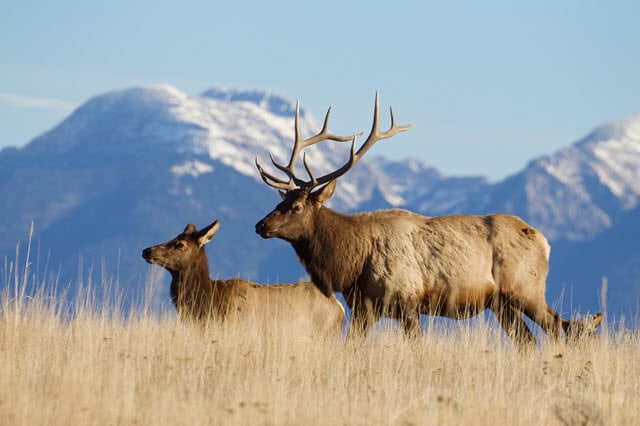
This type of elk usually has a relatively light coat color. The Rocky Mountain Wapiti has a wider neck than the Roosevelt subspecies.
Tule
The Tule elk (Cervus canadensis nannodes) is found in central California. In fact, California is the sole location where this cervid lives.
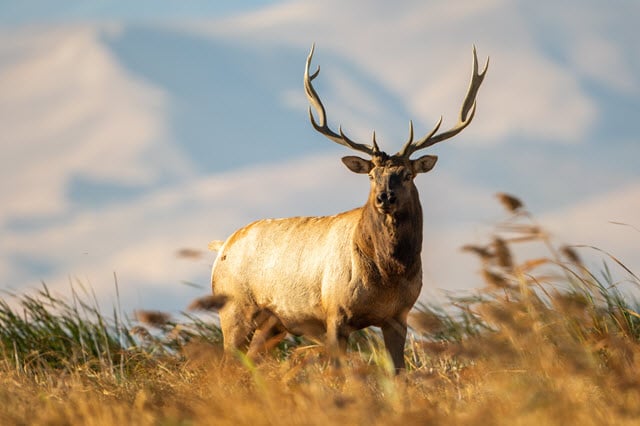
This subspecies has a smaller body size than any of the others.
Roosevelt
The Roosevelt subspecies has a larger body size than the other subspecies.
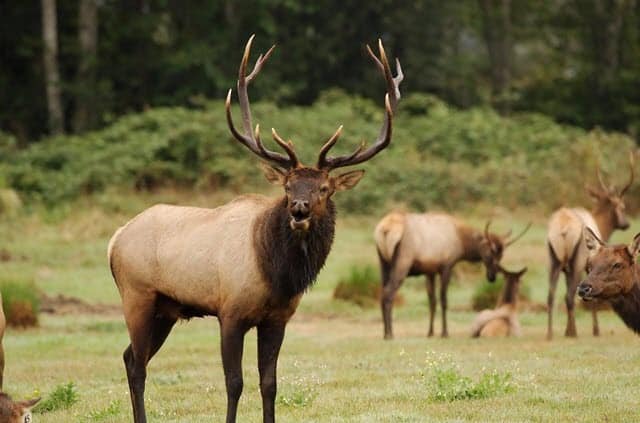
Cervus canadensis Roosevelt is found in several places including northern California and southeast Alaska. In Canada, it’s found in British Columbia.
Roosevelt elk tend to live in temperate rainforest environments.
Where Do Elk Live?
North American elk primarily live in western parts of the United States and Canada.
Populations begin in the Eastern Rockies and continue through to New Mexico.
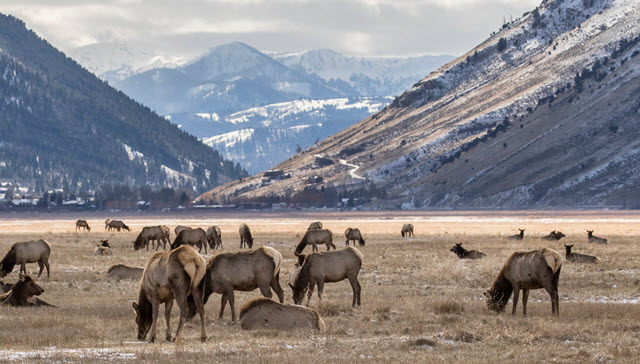
Wapiti also live on Michigan’s northern lower peninsula.
Distribution and Range
As of 2011, Wapiti were known to live in both the United States and Canada. Below are the specific states and provinces.
United States: Arkansas, Arizona, California, Colorado, Idaho, Kansas, Kentucky, Michigan, Minnesota, Montana, North Carolina, North Dakota, Nebraska, New Mexico, Nevada, Oregon, Pennsylvania, South Dakota, Texas, Utah, Washington, and Wyoming.
Canada: Alberta, British Columbia, Manitoba, Northwest Territories, Ontario, Saskatchewan, and Yukon.
In the United States, the states with the highest elk population numbers include:
- Montana: 170,000
- Idaho: 120,000
- Wyoming: 110,200
- Utah: 81,000
- Washington: 60,000
- Arizona: 35,000
Preferred Habitat
The elk’s favorite type of habitat is woodlands. This is an adaptable animal, however, and it can also thrive in mountainous areas, coniferous-hardwood forests, aspen-hardwood forests, coniferous swamps, and clear cuts.

When it comes to foraging for food, elk herds tend to focus on open fields of grass. They often feed in the late afternoon and early morning.
After they have done eating, they will go back into areas with better cover, such as dense woodland.
The Rocky Mountain and Roosevelt subspecies take part in seasonal migration. Each year, these animals travel long distances to reach meadows and forests in mountainous regions.
What do Elk Need?
Elk need the correct environments and foods for their diet. In the summer, their primary food needs include continued access to forbs and grasses for their food sources.
During the fall and spring, grasses form the bulk of an elk’s diet. When the winter arrives, deer need access to twigs, tree bark, grasses, and shrubs to eat.
Of course, they also need a consistent supply of water.
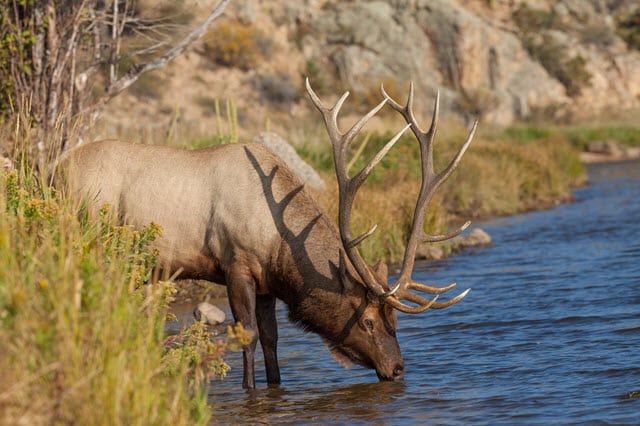
Some of the water sources these cervids use include streams, rivers, springs, ponds in wetlands, and lakes.
Like other prey animals, elk require access to places with cover, to help them hide from predators.
Elk are strong and powerful animals, and they’re able to handle challenging weather and climate conditions. That is why they can live and thrive in northern areas with severe winters.
These animals will move from area to area to cope with difficult weather conditions, such as snowstorms. If snowfall is too heavy, Wapiti will travel to places with less snow on the ground to seek favorable winter bedding areas.
Elk Lifespan
Elk in the wild may live as long as 10 to 13 years. In many cases, however, elk will live much shorter lives. They may not have enough food to eat, be killed by hunters, or succumb to illness.
There is the possibility of a much longer life if an elk lives in captivity. In fact, this animal may live as long as 25 years in ideal captive conditions.
Female Elk live longer than males on average.
The Intricate Mating Rituals of Elk
The behavior of elk during mating season is quite an astonishing spectacle. The rut usually occurs from early September to mid-October, and during this period, bulls engage in fierce competitions to win over cow groups for breeding rights.
One of the most iconic sounds of the wild is the elk’s bugle, an eerie, powerful vocalization that bulls use to assert dominance and attract females. The bulls also display their physical prowess through sparring matches, where they lock antlers with competitors in a show of strength.
The Role of Antlers in Elk Life
Antlers are a significant part of an elk’s life, playing a crucial role beyond just the rut. For bulls, these bony structures are tools for defense and displays of superiority. The process of antler growth every spring and shedding in winter also points towards the animal’s unique adaptations and health status.
Antlers are made of bone that regrows each year, covered in velvet that supplies nutrients to the developing structure. A bull’s antlers can tell you a lot about its age, genetics, and nutritional intake, which hints at the importance of antlers in the life of an elk.
Migratory Patterns: Following the Herd
One of the most compelling behaviors of elk is their migration. It’s a strategic movement driven by the changing seasons and the search for food and calving grounds. Elk herds can travel hundreds of miles from their summer to winter habitats, navigating through challenging terrain and sometimes crossing human development areas.
These migrations are vital for preserving the genetic diversity of populations as well as for their survival. Tracking these migrations helps researchers understand more about the elk’s needs and how to better protect their routes.
Human Interaction and Elk: The Hunter’s Perspective
For hunters, elk provide a challenging and rewarding experience. The pursuit of elk requires knowledge of their behavior, excellent tracking skills, and an understanding of their habitats. Hunters must also be aware of the regulations and ethical guidelines, such as those outlined in the proper ways to ethically hunt and harvest an elk.
Various products can aid in this endeavor, like elk calls, which mimic the sound of bugling to attract bulls during the rut. It’s said that these calls can be very effective when used correctly, bringing an elk within shooting range for an ethical harvest.
Popular Elk Hunting Gear: Reviews and Recommendations
For those looking to gear up for their next elk hunt, there are several key items to consider. The right equipment can make all the difference in the field, whether it be in terms of comfort, accuracy, or success rate.
Hunting Rifles
When it comes to choosing a rifle for elk hunting, options such as the Remington Model 700 and the Winchester Model 70 are often praised for their reliability and accuracy. Hunters appreciate the solid build and the precision these rifles provide, which are essential in taking an ethical shot.
Binoculars
Seeing your quarry from a distance is key to a successful hunt. Binoculars such as the Vortex Optics Viper or the Bushnell Trophy Binoculars come highly recommended for their durability and clear vision, often being noted in reviews for their ease of handling and excellent magnification.
Hunting Boots
Comfortable and durable footwear is a must, and boots like the Danner Pronghorn and the Irish Setter Elk Tracker score high marks in reviews for their support and waterproof features. Many hunters swear by their performance in rugged, wet terrain – a common condition when hunting elk.
Find This and More on Amazon
Elk in Folklore and Culture
The elk holds a significant place in various cultures, not just as a game species, but also as a symbol of strength, agility, and nobility. Indigenous communities, for instance, have revered the elk for centuries, considering them a source of powerful medicine and incorporating them into myths and legends.
In art and literature, elk often represent wildness, freedom, and the untamed aspects of nature. Their portrayal in media usually invokes a sense of wonder and respect for the natural world.
Supporting Elk Populations: Education and Advocacy
Being an advocate for elk conservation involves staying informed about wildlife biology, ecology, and the many factors impacting these animals. Educational outreach programs and wildlife viewing opportunities can inspire people to support conservation efforts and respect these magnificent creatures.
By visiting national parks, wildlife refuges, or participating in guided tours, individuals can get an up-close look at elk and learn about the significance of wildlife stewardship from experienced guides and rangers.
Elk Throughout the Seasons: A Year in the Life
The life of an elk over the course of a year is marked by a cycle of growth, survival, and reproduction. From the antler growth in the spring and summer’s lush feeding grounds to the fall rut and winter migrations, every season brings new challenges and behaviors.
Springtime sees new calves being born and animals shedding their heavy winter coats, while summer provides ample feeding grounds that prepare elk for the approaching harshness of winter. Each season is essential for the elk’s life cycle and its ability to thrive in the wild.
A Closer Look at Elk Populations Across Continents
While often associated with North America, elk populations span across the northern hemisphere, including parts of Asia. Each region’s elk have adapted to survive in specific environments, with subspecies like the Asiatic or Siberian elk surviving in environments that range from forests to subarctic tundra.
Understanding the global distribution of elk sheds light on their adaptability and the shared challenges all populations face, regardless of geography. Conservation efforts must take into account these varying habitats and the unique needs of elk depending on their location.
Elk Mating Habits & Reproduction
Elk mate each year during the breeding season in the fall. This is called the rut.
Males will have grown back their antlers by this time of year, and they use these to compete with other males for territorial dominance.
Mature male elks between 5 and 11 years old tend to gather harems of females.
Bull Elk make a bugling noise when they want to show dominance and a willingness to fight. This noise resembles whistling and is quite high-pitched.
Bulls try to avoid fighting if possible, but they are willing to enter a physical contest if necessary.
The female estrus cycle is quite short, with a one or two-day duration. Once a bull has mated with a receptive female, the gestation of calves takes from 240 to 262 days.
Females usually give birth to their young between late May and early June. After a calf is born, it will behave extremely cautiously for a few weeks.
Calves will hide as much as possible near their mother, avoiding movement that may attract attention.
How Elk Give Birth to their Calves
An elk cow may take several different positions when birthing its young. It may stand or lie down, and it will change its stance for comfort.
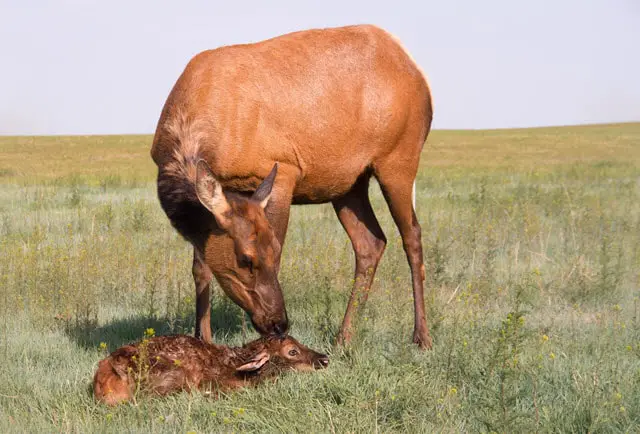
The average calf weight at birth ranges from 33 to 35 pounds. In most cases, only one calf will be born.
It is possible, though, for two calves to be born. Cows separate from the rest of the herd when it’s about to give birth.
Interesting and Notable Elk Facts
This species of deer is fascinating, with quite a few unique characteristics. Take a look at some of these below.
Vestigial Tusks
The elk’s smooth and rounded “eye” teeth are their upper canines. They aren’t just regular deer teeth: they are vestigial tusks.
In other words, they’re the remnants of what were once tusks in ancient Wapiti ancestors.
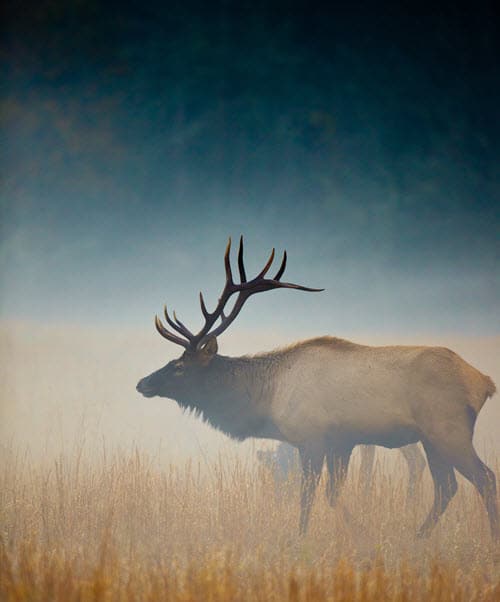
Today, they don’t appear to have a purpose.
Unfortunately, humans once frequently killed elk specifically for these teeth. This was because the demand for using these teeth in jewelry-making became unsustainable.
Poaching was a serious threat to the species in the 19th century.
Ability to Interbreed with Red Deer
These animals are related closely enough to Red Deer that they can reproduce (despite the fact that red deer are significantly smaller).
These deer species don’t share the same ranges, so it is unlikely to happen in the wild, but exotic hunting ranches will sometimes crossbreed species of deer to create more exotic looking trophies for their hunting guests.
Frequent Vocalization
Most ungulates, including deer, aren’t particularly vocal. Elk are different.
These animals use a variety of vocalizations to communicate with other members of the herd, sometimes almost constantly.
Noises they make include squeals, grunts, and more.
Rounded Hooves
The rounded shape of elk hooves makes them different from the hooves of other cervids. They have some shape similarities to yearling cattle hooves.

Sometimes this causes confusion in tracking and hunting.
Enthusiasm for Cold Temperatures
Remember, elk are built to deal with the winter. In fact, they love cold weather and thrive in the snow.
Cold temperatures tend to make these animals livelier and more interested in their surroundings. And these cervids have absolutely no objection to sitting and relaxing in the snow.
Longer Lifespan than Other Cervids
As we touched on earlier, Wapiti are one of the longest-lived types of deer in the world. This applies both in the wild and in captivity. Elk may live as long as 26.8 years.
Impressive Running Speed
Elk show impressive speeds. If they need to, they may run as fast as 45 miles per hour.
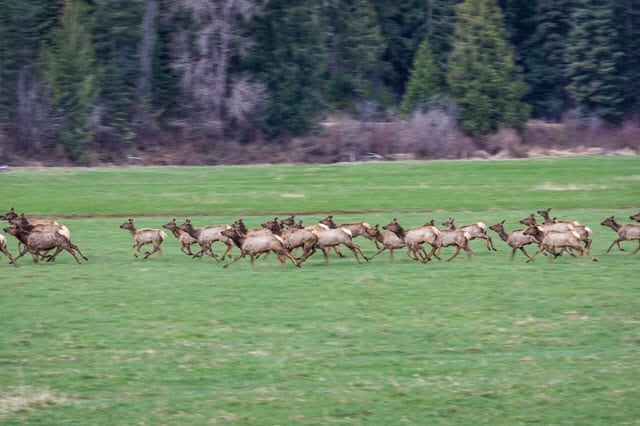
To understand just how fast this is, consider the maximum horse speed ever recorded was almost 44 miles per hour. These deer can only keep up their maximum speed for relatively short durations, but it’s still impressive (and surprising to many people).
They aren’t the fastest deer species, but they’re right up there.
Occasionally Omnivorous Eating Habits
This surprises many people because deer are so well-known as herbivores. But if the circumstances demand it, elk may eat small amounts of meat.
For example, elk may eat bird’s nest contents if they feel they need the nutrition it contains.
In some cases, they even eat nests just because they’re easy to find and nutrient-rich.
Extraordinary Jumping Ability
Despite their large size, these animals are able to make impressive jumps both horizontally and vertically. Even vertically, they can jump up to eight feet with little effort.
Elk Hunting
Elk hunting isn’t as common as white-tailed deer hunting, but it’s certainly a pursuit some outdoorsmen enjoy.
One of the many differences between elk and white-tailed deer is the quality of their eyesight. This means that Wapiti are sometimes easier to hunt.
But there is one significant way that elk hunting is more strenuous and challenging than white-tailed deer hunting. Wapiti travel far distances, and hunting them may require a lot of traveling (including on foot) for the hunter.
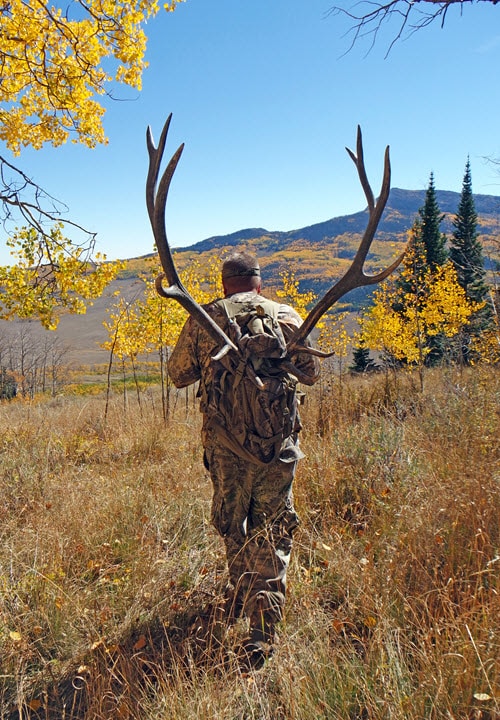
Hunting elk generally means dealing with difficult terrains. Hunting this species also requires a lot of strategy and knowledge of migration patterns.
Whitetail deer tend to live most of their lives over a relatively small range. Wapiti, on the other hand, travel all over mountainous areas all through the year.
What are Eurasian (or European) Elk?
The animal referred to as the European Elk is actually a moose. It is native to the Eurasian continent.
Like North American moose, Eurasian Elk are massive animals. They have short tails, long legs, and a substantial body.
Like the moose in North America, the Eurasian moose is the largest cervid in Europe. Unfortunately, the Eurasian elk is extinct in many parts of Europe and Asia where it once existed.
Experts believe this animal may have lived in Scotland as late as 900 AD. The main reason for extinction in various places was hunting and environmental pressure.
Final Thoughts on the North American Elk
Let’s review a few important points we learned about North American elk:
- Elk live in various regions of the United States and Canada.
- There were up to 10 million elk in North America before Europeans arrived.
- There were once six elk subspecies, but now there are only four: Manitoban, Rocky Mountain, Tule, and Roosevelt elk.
- “European elk” are actually moose, not elk.
As the second-largest deer species in the world, the North American elk is a majestic species well worth learning more about.
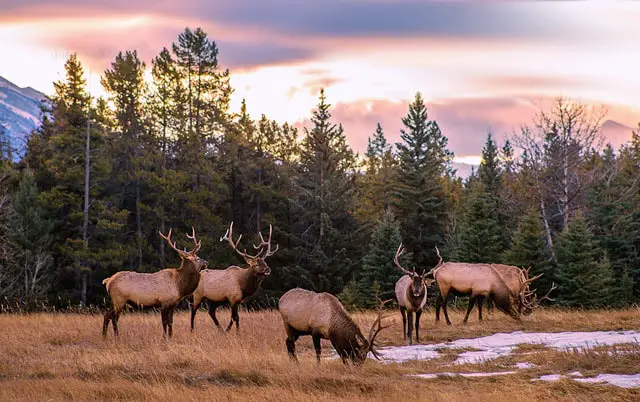
With continued environmental and protection measures, this animal will continue to thrive and grow in its native environments.

